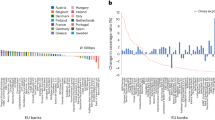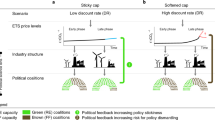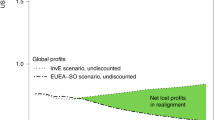Abstract
The risks imminent to younger technologies and markets may hinder renewable energy firms’ access to financing. This could curtail the investment needed for the transformation of the global energy sector. However, comprehensive analyses of the cost of debt of renewable and non-renewable energy firms are lacking. Here, we empirically analyse the differences between the costs of debt of firms developing and producing renewable energy technologies and of non-renewable energy firms. We use global micro-level data on individual loans matched to firm-level data. The results suggest that renewable energy firms might face a higher cost of debt initially, when technologies and markets are young and immature. However, a cost advantage of renewable energy firms emerges over time. The results also show that the costs of debt of renewable energy firms are lower in economies with a more developed banking sector and comparatively stringent environmental policies.
This is a preview of subscription content, access via your institution
Access options
Access Nature and 54 other Nature Portfolio journals
Get Nature+, our best-value online-access subscription
$29.99 / 30 days
cancel any time
Subscribe to this journal
Receive 12 digital issues and online access to articles
$119.00 per year
only $9.92 per issue
Buy this article
- Purchase on Springer Link
- Instant access to full article PDF
Prices may be subject to local taxes which are calculated during checkout




Similar content being viewed by others
Data availability
The data that support the findings of this study are available from Bloomberg and S&P Global Market Intelligence, but restrictions apply to the availability of these data, which were used under licence for the current study, and so are not publicly available. Country data on environmental policy stringency are available from the OECD Environmental Statistics36. Country data on the development of financial institutions are available from the IMF (ref. 38). The data that support the figures and other findings within this Article are, however, available from the authors upon reasonable request and with permission of Bloomberg and S&P Global Market Intelligence.
Code availability
The Stata code can be obtained from the authors upon reasonable request.
References
Best, R. Switching towards coal or renewable energy? The effects of financial capital on energy transitions. Energy Econ. 63, 75–83 (2017).
Egli, F., Steffen, B. & Schmidt, T. S. A dynamic analysis of financing conditions for renewable energy technologies. Nat. Energy 3, 1084–1092 (2018).
Kempa, K. & Moslener, U. Climate policy with the chequebook – an economic analysis of climate investment support. Econ. Energy Environ. Policy 6, 111–129 (2017).
Polzin, F. Mobilizing private finance for low-carbon innovation – s systematic review of barriers and solutions. Renew. Sustain. Energy Rev. 77, 525–535 (2017).
Ghoul, S. E., Guedhami, O., Kwok, C. C. & Mishra, D. R. Does corporate social responsibility affect the cost of capital? J. Bank. Financ. 35, 2388–2406 (2011).
Bauer, R. & Hann, D. Corporate environmental management and credit risk. SSRN https://doi.org/10.2139/ssrn.1660470 (2010).
Chava, S. Environmental externalities and cost of capital. Manag. Sci. 60, 2223–2247 (2014).
Valta, P. Competition and the cost of debt. J. Financ. Econ. 105, 661–682 (2012).
Haas, C. & Kempa, K. Low-carbon investment and credit rationing. SSRN https://doi.org/10.2139/ssrn.3521332 (2020).
Carpenter, R. E. & Petersen, B. C. Capital market imperfections, high-tech investment, and new equity financing. Econ. J. 112, F54–F72 (2002).
Guiso, L. High-tech firms and credit rationing. J. Econ. Behav. Organ. 35, 39–59 (1998).
Revest, V. & Sapio, A. Financing technology-based small firms in Europe: what do we know? Small Bus. Econ. 39, 179–205 (2012).
Howell, S. T. Financing innovation: evidence from R&D grants. Am. Econ. Rev. 107, 1136–1164 (2017).
Bharath, S. T., Dahiya, S., Saunders, A. & Srinivasan, A. Lending relationships and loan contract terms. Rev. Financ. Stud. 24, 1141–1203 (2011).
Jiménez, G. & Saurina, J. Collateral, type of lender and relationship banking as determinants of credit risk. J. Bank. Financ. 28, 2191–2212 (2004).
Petersen, M. A. & Rajan, R. G. The effect of credit market competition on lending relationships. Q. J. Econ. 110, 407–443 (1995).
Minetti, R. Informed finance and technological conservatism. Rev. Financ. 15, 633–692 (2010).
Packham, N. Structured climate financing: valuation of CDOs on inhomogeneous asset pools. SSRN https://doi.org/10.2139/ssrn.3533484 (2020).
Geddes, A., Schmidt, T. S. & Steffen, B. The multiple roles of state investment banks in low-carbon energy finance: an analysis of Australia, the UK and Germany. Energy Policy 115, 158–170 (2018).
Egli, F., Steffen, B. & Schmidt, T. S. Learning in the financial sector is essential for reducing renewable energy costs. Nat. Energy 4, 835–836 (2019).
McCrone, A., Moslener, U., D’Estais, F., Grüning, C. & Emmerich, M. Global Trends in Renewable Energy Investment 2020 (Frankfurt School-UNEP Centre/BNEF, 2020).
Ang, G., Röttgers, D. & Burli, P. The Empirics of Enabling Investment and Innovation in Renewable Energy OECD Environment Working Paper No. 123 (OECD, 2017); https://doi.org/10.1787/19970900
Brunnschweiler, C. N. Finance for renewable energy: an empirical analysis of developing and transition economies. Environ. Dev. Econ. 15, 241–274 (2010).
Haščič, I. et al. Public Interventions and Private Climate Finance Flows: Empirical Evidence from Renewable Energy Financing OECD Environment Working Paper No. 80 (OECD, 2015); https://doi.org/10.1787/5js6b1r9lfd4-en
Kim, J. & Park, K. Financial development and deployment of renewable energy technologies. Energy Econ. 59, 238–250 (2016).
Steckel, J. C. & Jakob, M. The role of financing cost and de-risking strategies for clean energy investment. Int. Econ. 155, 19–28 (2018).
Flammer, C. Corporate green bonds. SSRN https://doi.org/10.2139/ssrn.3125518 (2020).
Larcker, D. F. & Watts, E. M. Where’s the greenium? J. Account. Econ. 69, 101312 (2020).
Karpf, A. & Mandel, A. The changing value of the ‘green’ label on the US municipal bond market. Nat. Clim. Change 8, 161–165 (2018).
Egli, F. Renewable energy investment risk: an investigation of changes over time and the underlying drivers. Energy Policy 140, 111428 (2020).
May, N. G. & Neuhoff, K. Financing power: impacts of energy policies in changing regulatory environments. SSRN https://doi.org/10.2139/ssrn.3046516 (2017).
Chava, S., Livdan, D. & Purnanandam, A. Do shareholder rights affect the cost of bank loans? Rev. Financ. Stud. 22, 2973–3004 (2009).
Goss, A. & Roberts, G. S. The impact of corporate social responsibility on the cost of bank loans. J. Bank. Financ. 35, 1794–1810 (2011).
Berg, T., Saunders, A., Steffen, S. & Streitz, D. Mind the gap: the difference between U.S. and European loan rates. Rev. Financ. Stud. 30, 948–987 (2017).
Svirydzenka, K. Introducing a New Broad-Based Index of Financial Development IMF Working Paper No. 16/5 (IMF, 2016); https://doi.org/10.5089/9781513583709.001
Environmental Policy: Environmental Policy Stringency Index (OECD, accessed January 2020); https://stats.oecd.org/
Botta, E. & Koźluk, T. Measuring Environmental Policy Stringency in OECD Countries: A Composite Index Approach OECD Economics Department Working Paper No. 1177 (OECD, 2014); https://doi.org/10.1787/5jxrjnc45gvg-en.
Financial Developement Index Database (IMF, accessed January 2020); https://data.imf.org/
Acknowledgements
The Article benefited from discussions at the 2019 IAEE European Conference and the CARIMA symposium as well as the 2020 conferences of the AERE, EEA, GRASFI and VfS. We gratefully acknowledge the support from the German Federal Ministry of Education and Research within the Call ‘Ökonomie des Klimawandels’ (funding code 01LA1830A: Sustainable Finance and Its Impact (SUFI)). K.K. and O.S. are grateful for the support of the Robert Bosch Foundation.
Author information
Authors and Affiliations
Contributions
K.K., U.M. and O.S. developed the research idea. K.K. and O.S. collected and compiled the data. K.K. took the lead in conducting the econometric analyses in Stata and the presentation of results in tables and figures with significant input from U.M. and O.S. All authors jointly wrote the manuscript.
Corresponding author
Ethics declarations
Competing interests
The authors declare no competing interests.
Additional information
Peer review information Nature Energy thanks Rohan Best, Julie Byrne and Florian Egli for their contribution to the peer review of this work.
Publisher’s note Springer Nature remains neutral with regard to jurisdictional claims in published maps and institutional affiliations.
Supplementary information
Supplementary Information
Supplementary Tables 1–10 and Fig. 1.
Rights and permissions
About this article
Cite this article
Kempa, K., Moslener, U. & Schenker, O. The cost of debt of renewable and non-renewable energy firms. Nat Energy 6, 135–142 (2021). https://doi.org/10.1038/s41560-020-00745-x
Received:
Accepted:
Published:
Issue Date:
DOI: https://doi.org/10.1038/s41560-020-00745-x
This article is cited by
-
Meta-analysis on necessary investment shifts to reach net zero pathways in Europe
Nature Climate Change (2023)
-
Impact of dual control system of energy consumption and intensity on cost of debt financing: micro-evidence from Chinese listed companies
Environmental Science and Pollution Research (2023)
-
Low-Carbon Investment and Credit Rationing
Environmental and Resource Economics (2023)
-
Knowledge-Based Energy Investments of European Economies and Policy Recommendations for Sustainable Development
Journal of the Knowledge Economy (2023)
-
Bargaining power of new-energy enterprises in China’s credit-financing market
Environmental Science and Pollution Research (2022)



